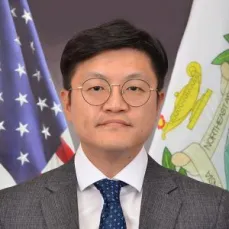The newly translated documents on China’s crisis management discussed below include:
- Strengthening Crisis Management is the Top Priority in Current China-U.S. and China-Japan Security Relations, by Zhang Tuosheng, a council member at the Institute of International and Strategic Studies at Peking University.
- Research on China’s Behavior in International Military Security Crises, by Zhang Tuosheng, a council member at the Institute of International and Strategic Studies at Peking University.
- Taiwan Strait Crisis and Risk Management: The Case of 1987-2017, by Chen Xiancai, director of the Institute of Political Science at Xiamen University’s Taiwan Research Institute.
- New Changes in the Sino-Indian Security Dilemma, and Their Consideration, by Liu Siwei, associate professor at the Institute of South Asian Studies, Sichuan University.
Jump to commentary from:
Amanda Hsiao | Sungmin Cho | Joel Wuthnow

Senior analyst, China, International Crisis Group
Since the 1990s, U.S. engagement with China on crisis management has drawn from its playbook with the Soviet Union, pushing with some success the establishment of hotlines and communication channels, maritime rules of behavior, and defense dialogues. This approach is predicated on the idea of establishing circuit-breakers—whether through timely communication between decisionmakers or through limitations on types of military maneuvers—that enable the de-escalation of a burgeoning crisis.
Two of the four articles, Zhang Tuosheng’s piece from 2021 (on China’s crisis management with the United States and Japan) and Liu Siwei’s from 2020 (on China’s management of its border dispute with India), offer suggestions that hew closely to the types of crisis management measures Washington often calls for—more communication channels, more rules, and more confidence-building measures. These recommendations are well-intentioned, but they belie the fact that the Chinese government has shown little actual interest so far in discussing crisis management with the Biden administration and has historically been willing to discard mechanisms when the bilateral relationship sours; in August 2022, for instance, Beijing cancelled three defense dialogues that have served as important platforms for discussing maritime rules and crisis management in the past.
China’s reluctance to engage with the United States on developing mutual crisis management mechanisms is better understood through the articles from Zhang in 2011 and Chen Xiancai in 2018, which show that the two authors’ concept of effective crisis management includes escalation and shows of military force as potentially necessary means. Chen writes: “Crisis escalation is often the only way to effectively resolve a conflict.” The goal of crisis management, per these writings, is not necessarily to de-escalate, but rather to protect or further Chinese interests in a crisis without triggering a military conflict. Or, as Zhang puts it, “fighting without breaking” (斗而不破).
For instance, for both Chen and Zhang the 1996 Taiwan Strait crisis was an example of effective crisis management: through a show of military force, Beijing deterred the United States and Taiwan from engaging in additional pro-Taiwan independence activities. (The Chinese military staged exercises between June 1995 and March 1996, including conducting missile tests some 56 km off of Taiwan’s two main commercial ports.) Zhang writes: “After this test of strength, the United States gained a new understanding and awareness of the sensitivity of the Taiwan issue.”
These pieces are thus an important reminder that using escalation to heighten a sense of risk is part of China’s modus operandi, a tool that Beijing believes can be useful for shaping the calculations of potential adversaries. In this light, it is little wonder that Beijing has been disinterested in utilizing and expanding crisis management mechanisms aimed at reducing risk for Washington’s military operations in China’s neighborhood; Beijing believes doing so would make it easier for the U.S. military to increase its presence.
These writings also illuminate the way in which Washington’s and Beijing’s conceptions of crisis management are misaligned, complicating the two governments’ abilities to ensure that competition does not unintentionally slip into conflict.
Beijing’s approach to crisis management is probably not static. In his 2011 piece, Zhang documents what he sees as a shift in how China approaches international security crises, from relying on military confrontation during the Cold War to emphasizing crisis management in the years since. However, an approach that aligns more closely with that of Washington is likely still far off in the making. Zhang credits two main factors—better internal decisionmaking (from decisionmaking by a few during the Mao era to collective and institutionalized decisionmaking in the Deng era) and an improved international environment (in which China no longer faced military threats and had better relations with its neighbors)—for China’s embrace of a more calibrated and diplomatic approach. Given that trends on both fronts are moving in the opposite direction, it is likely that Beijing’s management of near-term crises will be more confrontational than compromising.


Professor, Daniel K. Inouye Asia-Pacific Center for Security Studies (DKI APCSS)
It is unsurprising that the four Chinese scholars cited in the Interpret: China project persistently point to the United States as the root cause of China’s external problems. The narratives that the United States “intervenes in Taiwan affairs” or “uses India to contain China” are somewhat typical. But it is interesting that Liu Siwei, in his article on Sino-India relations, recognized the effects of security dilemma. Liu stressed that “[China and India] need to consider creating some new mechanisms for communication and dialogue.” Similarly, Zhang Tuosheng wrote, “senior leaders of China and the United States . . . should reach a consensus on the basic principles of crisis management” through “dialogues.” On cross-strait relationships, Chen Xiancai assessed that “in the past 30 years, the institutionalized consultation mechanism between the two sides of the Taiwan Strait has also made some progress.” All these Chinese scholars advocate dialogue and diplomacy for crisis management.
This is a welcome thought, because U.S. scholars have also increasingly been calling for a revitalization of diplomacy. There seem to be two challenges, however, to resuming dialogue as these Chinese writers recommend. First, it remains unclear whether Chinese leaders would follow the policy recommendations of civilian academics. After the 20th Party Congress, few officials would dare give Xi Jinping honest feedback on the negative effects of “wolf-warrior diplomacy.” “Security” was the most-mentioned word in Xi Jinping’s speech, and Xi gave no hints to moderate China’s aggressive foreign policy. Ironically, there is a case to be made that the more Xi speaks about “security,” the more his sense of insecurity is revealed. Beneath the look of confidence, Xi might feel insecure for domestic dissatisfaction with “zero-Covid” policies, mismanagement of the economy, and China’s negative international image. One can reasonably assume, then, that an endless escalation of tension with the United States is not in the interest of the Xi regime. If Xi were to seek out opinions on crisis management from a group of civilian experts, he would hear few creative ideas beyond dialogue and diplomacy, as these Chinese scholars have written.
The logistics of diplomacy pose the second challenge. Due to China’s zero-Covid policy, it remains difficult for diplomats and officials to meet in person. At the point of writing, the quarantine for foreign travelers to China remains 10 days. Although this is greatly shortened from the previous 21 days, spending 10 days at a hotel is still a big challenge for U.S. diplomats visiting China. Chinese nationals who return from a trip abroad also have to quarantine for seven days at an isolation facility and then three days at home.
One way to get around this second challenge is to revitalize meetings at the track 2 level first. Scholars and think-tankers are relatively free from the bureaucratic burdens that constrain government officials from meeting at the track 1 level. Zhang Tuosheng precisely suggests that “communication and dialogues should not be limited to the official level, but should also include track 2 exchanges such as academic community and think tank community exchanges.” Alternatively, arranging meetings in a third-party country without quarantine requirements could be considered if Chinese scholars are willing to travel and cooperate. This would save time for U.S. scholars, at least. In such a case, South Korea or Thailand could be a good place to host track 2 meetings.
Of course, dialogue in and of itself will not solve the issues between the United States and China. The U.S. strategy still needs to focus on deterrence and balancing against China at the strategic level. But this does not mean that Washington is allowed to rule out tools of diplomacy. Rather, precisely because the United States has shown a strong resolve to compete with China in the last five years or so, it is now in a better position to retry diplomacy than in the past. The primary objective of diplomacy at this stage is to test Xi’s will to cooperate on crisis management. The four articles reviewed in the Interpret: China project suggest that such an idea was discussed in China, passed censorship, and got published with the party’s approval.


Senior research fellow, Center for the Study of Chinese Military Affairs, Institute for National Strategic Studies, National Defense University
U.S.-China military relations reached a low point following Speaker of the House Nancy Pelosi’s August 2022 visit to Taiwan, when Beijing suspended three initiatives: the Military Maritime Consultative Agreement, which is a forum to discuss dangerous maritime and air encounters between U.S. and Chinese forces; a proposed dialogue between theater commanders, who oversee those forces; and the annual Defense Policy Coordination Talks, in which the two sides discuss security challenges and negotiate an annual engagement plan. This wasn’t the first time that political posturing has derailed military-to-military talks, but the stakes are higher than ever—with an intensifying competition between Washington and Beijing, such channels can be useful in preventing and managing conflicts.
The benefits of conflict management have been internalized by some members of China’s strategic community, judging by contributions from three scholars: Zhang Tuosheng, a think tank expert who has frequently called for upgraded U.S.-China security dialogues and confidence-building measures; Liu Siwei, a Sichuan University academic who has applied the logic of risk reduction to Sino-Indian tensions; and Xiamen University professor Chen Xiancai, writing in a Taiwan context. All three recognize the dangers in allowing tensions between China and its adversaries to fester without installing safety valves and off-ramps. Their concern is not theoretical but rooted in practical interests: any conflict originating in accidents or miscalculations could bring grave harm to China’s own development.
There are reasons, however, to doubt whether these articles reflect internal thinking and decisionmaking in China. One problem is that the authors are civilian scholars. While these individuals might be well versed in theories of conflict management, how confident can one be that their outlook is shared by top People’s Liberation Army officers? The appointment of a new Central Military Commission in October 2022 does not offer much encouragement. While their résumés are long on operational expertise, few of the new leaders have interacted with U.S. officials. The incoming defense minister, Li Shangfu, has even been subjected to U.S. sanctions due to his role in the purchase of advanced Russian systems. Whether any of them will advocate restoring U.S.-China talks remains to be seen.
Another issue is whether the strategic communities on both sides can adequately understand the action-reaction cycles that are driving tensions in the first place. The Zhang and Liu articles both offered hope by suggesting that frictions with the United States and India, respectively, are due to decisions taken by both sides (and, for Liu, enflamed by nationalistic discourse). It is likely, however, that the Chen article—which fully blames the persistence of tensions across the Taiwan Strait on Taipei and Washington, absolving Beijing of any responsibility—more accurately reflects the myopia that has reduced the prospects for productive talks. Even when dialogues such as the Military Maritime Consultative Agreement do occur, their utility has been limited by presentations more likely to focus on the wrongdoing of the other side than on constructive exchanges.
Finally, the prescriptions offered in two of the articles appear to be disconnected from the reality of Chinese politics. A common observation of U.S.-China negotiations is that while U.S. participants often value concrete steps to build confidence, the Chinese side focuses more on agreements on principles. Zhang and Liu offer bottom-up proposals such as hotlines and track 2 dialogues that are likely to resonate in U.S. circles, but that are unlikely to have much salience in the Chinese bureaucracy without a prior political consensus. Xi Jinping and Joseph R. Biden Jr. have spoken of the need to establish “guardrails” on U.S.-China relations, but progress stalled with the increase of tensions related to Taiwan.
Support for progress on conflict management within China’s strategic community, as reflected not only in these essays but also in the ability of Chinese scholars to publicly offer such suggestions in China’s constrained political environment, is encouraging. However, restoring hope for successful U.S.-China engagement will only be likely under three conditions: buy-in from China’s new military leaders, constructive talks based on an awareness of the action-reaction cycle, and prioritization from the two principals. Without such progress—starting with a resumption of the canceled exchanges—the chances for a mutually damaging clash in the Indo-Pacific will only become greater.
This essay represents only the views of the author and not those of National Defense University, the Department of Defense, or the U.S. government.
To top